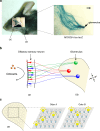Neural map formation in the mouse olfactory system
- PMID: 24638094
- PMCID: PMC4111858
- DOI: 10.1007/s00018-014-1597-0
Neural map formation in the mouse olfactory system
Abstract
In the mouse olfactory system, odorants are detected by ~1,000 different odorant receptors (ORs) produced by olfactory sensory neurons (OSNs). Each OSN expresses only one functional OR species, which is referred to as the "one neuron-one receptor" rule. Furthermore, OSN axons bearing the same OR converge to a specific projection site in the olfactory bulb (OB) forming a glomerular structure, i.e., the "one glomerulus-one receptor" rule. Based on these basic rules, binding signals of odorants detected by OSNs are converted to topographic information of activated glomeruli in the OB. During development, the glomerular map is formed by the combination of two genetically programmed processes: one is OR-independent projection along the dorsal-ventral axis, and the other is OR-dependent projection along the anterior-posterior axis. The map is further refined in an activity-dependent manner during the neonatal period. Here, we summarize recent progress of neural map formation in the mouse olfactory system.
Figures





References
-
- Miyamichi K, Serizawa S, Kimura HM, Sakano H. Continuous and overlapping expression domains of odorant receptor genes in the olfactory epithelium determine the dorsal/ventral positioning of glomeruli in the olfactory bulb. J Neurosci. 2005;25:3586–3592. doi: 10.1523/JNEUROSCI.0324-05.2005. - DOI - PMC - PubMed
Publication types
MeSH terms
Substances
LinkOut - more resources
Full Text Sources
Other Literature Sources
Miscellaneous

